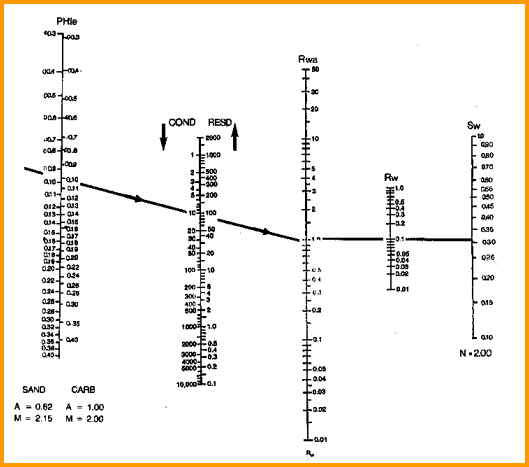|
 ARCHIE WATER Saturation
ARCHIE WATER Saturation
This method is the old standard of the industry, but is now restricted
to clean sands and carbonates. It requires a good value for water
resistivity. All shale corrected saturation models revert to this
equation when Vsh = 0, so shale corrected models are usually run
when using computer-aided log analysis software.
The
exponents A and M should be calibrated to the particular zone
being analyzed.
 Water Saturation
from the Archie Method
Water Saturation
from the Archie Method
1:
IF PHIe <= 0.0
2: OR IF Vsh >= 0.9
3: THEN Swa = 1.0
4: OTHERWISE Swa = (A * RW@FT / (PHIe ^ M) / RESD) ^ (1 / N)
Where:
A = tortuosity exponent (unitless)
M = cementation exponent (unitless)
N = saturation exponent (unitless)
PHIe = effective porosity (fractional)
RESD = resistivity of zone (ohm-m)
RW@FT = water resistivity at formation temperature (ohm-m)
Swa = water saturation from Archie method (fractional)
COMMENTS:
See below.
Swa2 - Water Saturation from Apparent Water Resistivity
The
Archie formula can be rewritten as:
5: IF PHIe <= 0.0
6: OR IF Vsh >= 0.9
7: THEN Swa = 1.0
8: OTHERWISE Rwa = (PHIe ^ M) * RESD / A
9: AND Swa = (RW@FT / Rwa) ^ (1/N)
Where:
A = tortuosity exponent (unitless)
M = cementation exponent (unitless)
N = saturation exponent (unitless)
PHIe = effective porosity (fractional)
RESD = resistivity of zone (ohm-m)
Rwa = apparent water resistivity (ohm-m)
RW@FT = water resistivity at formation temperature (ohm-m)
Swa = water saturation from Archie method (fractional)
 COMMENTS:
COMMENTS:
This is a convenient form if using the Rwa values as guides to
finding an appropriate RW@FT value to use in the saturation equation.
This equation is not shale corrected, so it should not be used
in shaly zones.
References:
1. Electrical Resistivity Log as an Aid in
Determining Some Reservoir Characteristics
G.E. Archie, Journal of Petroleum Technology, 1941
2.
Resistivity
of Brine Saturated Sands in Relation of Pore Geometry
W.O. Winsauer, H.M. Shearin, P.H. Masson, and M.
Williams. AIME, 1952
A
quick look version of this formula sets A = 1.0, M = 2.0 and N
= 2.0. Thus:
10: Swa = (RW@FT / (PHIe ^ 2) / RESD) ^ 0.5
This
formula can be calculated by mental arithmetic or on a scratch
pad when needed, and is accurate enough for quick look work.
The
graphical solution to the Archie formula is provided below.

Nomograph to solve Archie equation
 RECOMMENDED
PARAMETERS:
RECOMMENDED
PARAMETERS:
for
carbonates A = 1.00
M = 2.00
N = 2.00 (Archie Equation as first published)
for sandstone A = 0.62
M = 2.15
N = 2.00 (Humble Equation)
A = 0.81 M = 2.00 N = 2.00 (Tixier Equation -
simplified version of Humble Equation)
NOTE:
N is often lower than 2.0
For
quick analysis use carbonate values. Values for local situations
should be developed from special core data. Results will always
be better if good local data is used instead of traditional values,
such as those given above.
Asquith (1980 page 67) quoted other authors, giving values for A
and M, with N = 2.0, showing the wide range of possible values:
Average sands A = 1.45 M = 1.54
Shaly sands
A = 1.65 M = 1.33
Calcareous sands
A = 1.45 M = 1.70
Carbonates
A = 0.85 M = 2.14
Pliocene sands S.Cal. A = 2.45 M = 1.08
Miocene LA/TX
A = 1.97 M = 1.29
Clean granular
A = 1.00 M = 2.05 - PHIe
 NUMERICAL
EXAMPLE:
NUMERICAL
EXAMPLE: |
| 1.
Using data from Sands A, B, C and D as before: |
| |
Sand
A |
Sand
B |
Sand
C |
Sand
D |
| RESD |
20 |
40 |
1.2 |
1.0 |
| PHIe |
0.33 |
0.23 |
0.30 |
0.11 |
| A |
0.62 |
0.62 |
0.62 |
0.62 |
| M |
2.15 |
2.15 |
2.15 |
2.15 |
| Rwa |
2.97 |
2.73 |
0.145 |
0.014 |
| RW
@ FT |
0.9 |
0.9 |
0.036 |
0.015 |
| N |
2.0 |
2.0 |
2.0 |
2.0 |
| Swa |
0.55 |
0.57 |
0.50 |
1.03 |
Sample:
Swa = (0.62 * 0.9 / (0.33 ^ 2.15) / 20) ^ (1 / 2.0) = 0.55
Note
that the value for Sand D (shaly sand) is inaccurate and requires
additional work, because this method is poorly suited to shaly
sands.
|

